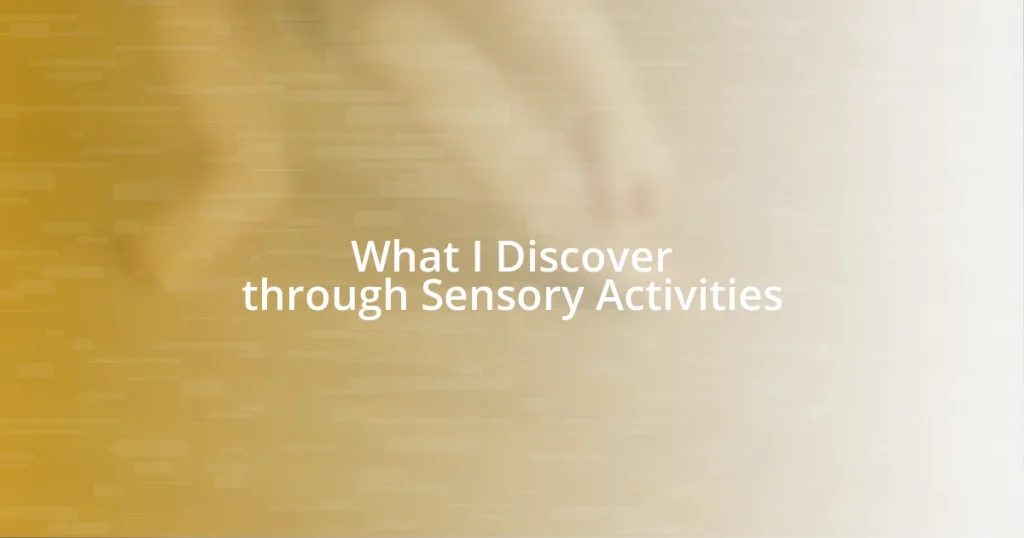Key takeaways:
- Sensory activities engage the five senses, promoting exploration, learning, emotional well-being, and social connections.
- Examples of sensory activities include tactile play, nature exploration, cooking, art, and music, each fostering unique sensory experiences.
- Creating a conducive environment and incorporating sensory elements at home enhances engagement, making activities more memorable and enjoyable.

Understanding sensory activities
Sensory activities are experiences that engage our five senses: sight, sound, touch, taste, and smell. I remember vividly setting up a simple water table for my niece. The joy on her face as she splashed around felt profound. It made me realize how these activities not only provide entertainment but also foster exploration and learning.
When we engage in sensory play, we tap into a deeper level of understanding about our environment and ourselves. Have you ever touched a rough surface and felt compelled to explore further? That tactile feedback is crucial in developing motor skills and cognitive understanding. I’ve seen children become more curious about their surroundings after playing with different materials, like sand or clay, which sparks their creativity.
Moreover, sensory activities often evoke emotions and memories that can be transformative. For me, the smell of freshly baked cookies brings back childhood moments spent in my grandmother’s kitchen. These activities create connections that help us relate to our past while also enriching our present, making sensory experiences invaluable for personal growth and development.

Benefits of sensory engagement
Sensory engagement can significantly enhance learning and development. I’ve witnessed this firsthand when working with children. One of my fondest memories involves using scented playdough to teach kids about different textures and smells. Their faces lit up with curiosity, transforming what could have been a mundane lesson into a vibrant exploration. The connection they forged with the materials deepened their understanding, proving that sensory experiences can make learning more memorable.
Additionally, sensory activities promote emotional well-being. There’s something incredibly calming about the repetitive motions involved in activities like painting or playing with rice. I often find solace in creating art, and I’ve seen how it can soothe not only kids but adults as well. Engaging our senses allows us to express feelings that may be difficult to articulate with words. Isn’t it fascinating how something as simple as mixing colors can create a sense of peace and joy?
Furthermore, sensory engagement fosters social interactions and collaboration. I remember hosting a community event where we set up interactive stations filled with various sensory materials. People mingled, laughed, and shared stories as they engaged in activities together. This collective involvement not only created connections among participants but also cultivated a sense of belonging. It’s amazing how sensory experiences can break down barriers and bring people together in such a meaningful way.
| Benefits of Sensory Engagement | Examples from Personal Experience |
|---|---|
| Enhances Learning | Using scented playdough aids in texture and smell recognition. |
| Promotes Emotional Well-being | Creating art provides calmness and emotional expression. |
| Fosters Social Interaction | Community events encourage connections through sensory activities. |

Types of sensory activities
Sensory activities can take many forms, each tailored to engage our senses in unique ways. I often find myself returning to simple, nature-based activities that evoke a variety of responses. For instance, I once set up a flower-picking scavenger hunt for some friends in my backyard. As we explored colors and smells, it sparked lively conversations about our favorite scents and the memories they triggered. A simple activity transformed into a heartwarming experience filled with laughter and connection.
Here are some common types of sensory activities:
- Tactile Play: Materials like sand, rice, or playdough encourage exploration through touch and texture.
- Nature Exploration: Activities like foraging or sensory walks highlight the sights, sounds, and scents of the outdoors.
- Cooking and Baking: The process engages taste, smell, and even sound as we mix and measure ingredients.
- Art and Craft: Painting, drawing, and crafting stimulate vision and touch while allowing for personal expression.
- Musical Experiences: Listening to or creating music taps into auditory senses, often evoking emotions and memories.
Each of these activities has a special way of connecting us to our feelings and to others, enriching our lives in delightful ways.

How to create sensory experiences
Creating sensory experiences isn’t just about the activities themselves; it’s about how those activities resonate with us on a deeper level. For instance, I once set up a nature collage project where we gathered leaves, flowers, and pinecones, and glued them onto canvas. The moment someone discovered the intricate patterns on a leaf or the velvety touch of a flower petal, it sparked a flurry of excitement and creative ideas. We weren’t just crafting; we were engaging with nature in a way that felt organic and alive. Have you ever noticed how a simple exploration of textures can leave you with lasting memories?
One engaging approach I’ve found is to integrate scents into experiences. I remember infusing a cooking session with aromatic herbs, encouraging everyone to smell and taste as they prepared a dish together. The kitchen echoed with laughter, and each new aroma drew comments and shared stories. It struck me how the sense of smell can trigger vivid memories, connecting us not just to the present moment, but also to our past experiences. Isn’t it incredible how something as ephemeral as a scent can evoke such strong emotions?
Additionally, I believe the environment we create plays a pivotal role in sensory experiences. For example, dimming the lights and adding soft music during a painting night can transform the atmosphere entirely. It invites participants to relax and immerse themselves in their creative process. In those moments, I’ve watched people let go of their inhibitions, allowing their true colors to shine through. Have you ever experienced a space that felt so right, it seemed to inspire creativity all on its own? It’s amazing how the right setting can enhance our sensory engagement.

Incorporating sensory activities at home
Incorporating sensory activities at home can be as simple as setting up a cozy corner for exploration. I once transformed a small table in my living room into a ‘sensory station’ filled with different textured fabrics, natural objects, and even some artistic supplies. It became a special retreat where my friends and I would experiment with our senses, chatting about how each texture made us feel. Have you ever had one of those moments where the feel of an object sparks an unexpected memory?
Another idea that has worked wonders for me is creating themed sensory evenings. I remember hosting a “taste and sound night” where we sampled different international dishes while listening to music from those cultures. The combination of flavors and melodies didn’t just tantalize our taste buds but also transported us to distant lands through our imaginations. It’s fascinating how food and music can be intertwined, don’t you think?
Lastly, incorporating sensory elements into family game nights can create memorable experiences. I once brought in scented candles to enhance the vibe while we played games, encouraging everyone to share stories related to the scents. It turned our typical game night into a journey through memory, as people reminisced about childhood experiences tied to particular aromas. Have you noticed how incorporating scent can transform even the simplest gatherings? It’s a delightful reminder of how our senses can connect us in unexpected ways.

Resources for sensory activity ideas
Finding resources for sensory activity ideas can open up a world of engaging experiences. One of my go-to places is online platforms like Pinterest, where I stumbled upon a treasure trove of sensory play activities. I remember scrolling through countless ideas and suddenly discovering DIY sensory bins filled with rice, beans, or sand. Have you ever tried letting your hands dive into a sensory bin? The tactile experience can be incredibly grounding and joyful!
Books are another fantastic resource that can provide structured approaches to sensory activities. I once picked up a book specifically dedicated to sensory play. It was fascinating how detailed it was—covering everything from the science behind sensory input to step-by-step ideas for engaging activities. The chapter on using everyday materials like water and bubbles ignited a sense of nostalgia for those carefree moments of splashing and laughter. Isn’t it amazing how something as simple as a bubble can delight all ages?
Local community centers and libraries often host workshops and classes centered around sensory activities. I once participated in a creative art class that incorporated different mediums—clay, paint, and fabric. Not only did I get to try my hand at new techniques, but I also met wonderful people who shared their own sensory experiences. That interaction added layers to my understanding of how we can all benefit from art and sensory exploration. Have you explored what your local community offers in this regard? It might just surprise you!















